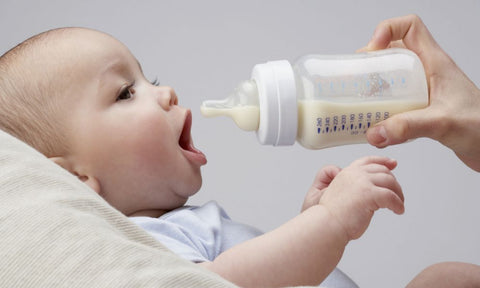VIRUS PROTECTION 101: HOW TO PROPERLY SANITISE AND STORE BABY’S FEEDING ITEMS

Prevent germs from contaminating the milk you feed your baby
Babies are vulnerable to the environment, which is why it is crucial that utmost care is taken of what goes into their mouth, as the mouth is the primary entry point to the body. With what’s happening in the world right now, sterilisation has never been more important, as it helps kill these microbes and cleans your baby’s feeding items thoroughly.
Harmful microorganisms can be deposited on the bottle and once these bacteria and viruses enters your baby’s body, it can result in vomiting and diarrhoea. Furthermore, when a child is born, his store of antibodies is limited to those that have been passed on from his mother during the last three months of pregnancy. This protection wanes in the first few months of his life.
Cleaning feeding items in the dishwasher
First you need to separate all bottle parts (for example, bottles, nipples, caps, rings, valves). Then, rinse bottle parts and any other feeding items by holding them under running water. The water can be warm or cold, whatever you prefer. Place bottle parts and other feeding items in the dishwasher. Be sure to place small items into a closed-top basket or mesh laundry bag so they don’t end up in the dishwasher filter. If possible, run the dishwasher using hot water and a heated drying cycle (or sanitising setting); this can help kill more germs. Wash your hands with soap and water before removing and storing cleaned items.
If items are not completely dry, place them on a clean, unused dish towel or paper towel to air-dry thoroughly before storing in an area free of dust or dirt. Do not use a dish towel to rub or pat items dry because doing so may transfer germs to the items.
Cleaning feeding items by hand
Of course, you should first wash your hands well with soap and water for 20 seconds. Then take apart the items and rinse. Next, place all items in a clean basin or container used only to clean infant feeding items. Do not wash directly in the sink because it may contain germs that could contaminate these items. Fill wash basin with hot water and add soap. Scrub items using a clean brush that is used only to clean infant feeding items. Squeeze water through nipple holes to be sure they get clean.
Rinse again by holding items under running water, or by holding completely under fresh water, in a separate basin that is used only for cleaning infant feeding items. Place bottle parts, wash basin, and bottle brush on a clean, unused dish towel or paper towel in an area protected from dirt and dust. Allow to air dry thoroughly. Again, do not use a dish towel to rub or pat.
Lastly, rinse the wash basins and brush well and allow them to air-dry after each use. Wash them every few days, either in a dishwasher with hot water and a heated drying cycle (if they are dishwasher-safe), or by hand with soap and warm water. If your baby is less than 3 months old, was born prematurely, or has a weakened immune system due to illness (such as HIV) or medical treatment (such as chemotherapy for cancer), wash basin and bottle brush after every use.
Provide the best comfort possible for your baby! Check out our product, the Funki Flamingo Premium Baby Carrier. It is designed to distribute the weight evenly throughout the wearer’s body to avoid physical discomfort.
Watch the video below to learn more about the Funki Flamingo Premium Baby Carrier.
